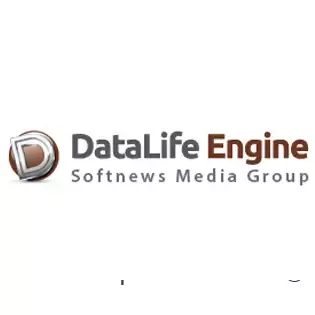Before you start installing DLE on hosting, let's get acquainted with the very concept of DLE.
DataLife Engine (DLE) is a content management system (CMS). WordPress, Joomla, Opencart, Bitrix and other CMS are quite common and are among the most popular engines of any sites. Actually, they are managed by the DLE system.

Initially, DLE was created to regulate news portals and resources, but over time, its functionality has grown and has been used on various leisure portals (streaming platforms, video game sites, etc.). The DLE system is universal, but has its pros and cons.
Note the following advantages:
DataLife Engine has high performance. With less resources consumed, you can easily deploy resource-intensive sites that use less powerful hardware on the server.
You can evaluate and comment on content with a huge number of tools, which increases the speed of deployment of both modest and large-scale information resources.
DLE interacts with search bots, so there is no need for additional SEO plugins.
Of the disadvantages , two main ones stand out:
A huge number of vulnerabilities. Of course, they are corrected by the developers as they are revealed, but you never know where the next one pops up.
It is quite difficult to update the system. There are non-automated structures in some components, and they are quite confusing, so any corrections are made in the code itself.
Having studied all the advantages and disadvantages of DataLife Engine, you can proceed with the installation.
Installing DLE on virtual hosting
First you need to download the DLE distribution from the official website, where in the repository dle-news.ru/release the DLE installation script is purchased. Files are downloaded and unpacked in any directory, which makes it easier to find them in the future.
You can upload files for installation on hosting in one of two ways: — in the hosting control panel (on hoster.ru this is done in your personal account in the section Management-Hosting-Working with files, where the contents of the upload directory from the distribution are transferred to the site folder); — via FTP connection if there is an FTP client (for example, FileZilla). Access data can be found in the Management-Hosting section.
You need to change the access rights so that you can read and write downloaded files. The rights are registered either in the hosting control panel in the section Management-Hosting-Working with files, or via an FTP client, specifying the rights for the templates folder in the numerical equivalent of 777 and then 666 with a tick marked in the redirection point to nested directories.
Finally, we proceed directly to the installation of DLE. In the browser, you must enter the path to the DLE installation script in the address bar, for example, http://test.ru/install.php where test.ru — this is the domain name (the presence of a domain is mandatory, you can even test it attached to the directory). This link opens the DataLife Engine interface, and the installation begins here. After agreeing to the CMS terms of use, you need to check the server for compliance with the minimum DLE requirements and click "Continue".
In the tab that opens, enter the database information: name, user, password and MySQL server. Next, we prescribe all of the above to create a new user directly in the CMS itself (login and password). In the file manager, you need to delete the script install.php and that's it!
Installing DLE on VDS
There are three ways to install DLE on a dedicated server:
In the hosting control panel, if there is support for this site management system.
In the command line (console), if there is no support for automated installation from the hosting provider.
Via a third-party control panel (for example, ISPmanager)
Let's consider the last two methods, since many hosting providers on virtual servers do not have DataLife Engine support, including on hoster.ru . Before installing DLE, you need to make sure that the server has a working domain to which you can link the site files.
Installing DLE via ISPmanager
First of all, a database is created, since the operation of any CMS depends on the availability of a database. It will also be addressed by DLE. When going to the ISPmanager control panel on the left in the menu, go to Tools — Databases. Create a database with the following parameters: name, MySQL server type, encoding (UTF-8 is the standard). Next, a user and password are created (the name can be any, and the password is generated based on the specified requirements). We save the data.
Similarly to uploading to a virtual hosting, the DLE distribution is downloaded. In ISPmanager, go to the "System" tab, then to the file manager. From above, click "Order" and select the downloaded installation file.
We place the files in the main directory by clicking "Extract", specifying the directory where the unpacking will take place. Find and open the upload folder. Having selected all the DLE components, click "Copy", specifying the root directory of the server. To be able to edit files, the permissions must also be 777 and 644, respectively.
The process of installing DLE is similar to installing on a virtual hosting: in the browser, we type http://test.ru/install.php (where test.ru — connected domain) and then follow the instructions of the installer.
Installing DLE via the command line (console)
If it is not possible to install via the graphical interface, there is an option to enter certain commands in the console or command line. If you already have some experience in the terminal, it will be quite simple.
Before proceeding with the installation, it is necessary to register the domain name in the hosts file, where the root directory for storing the main files of the site or other resource is indicated.
To connect to the north, you need to open a terminal (if Linux or macOS are installed) and enter a command via SSH connection. Admit:
ssh root@ip
where IP is the address of your server is indicated mainly in the VDS control panel.
If Windows OS is installed on the PC, you will need to install the Putty program, where you enter your IP and click OK. The connection takes place by entering a password, which is usually sent by the provider by mail. By connecting to the server via SSH access, you can start installing DLE.
By analogy with ISPmanager, a database is created. The only difference is that it is created manually. To do this, you need to install the mysql utility:
"package manager name" install mysql
Next, a database is created:
mysql> CREATE DATABASE "database name"
After that, a user is created:
mysql> CREATE USER any_name@localhost IDENTIFIED BY "your password"
We prescribe the rights for the newly created user:
mysql> GRANT ALL PRIVILEGES ON "database name" TO user@localhost
Next, enter the command:
mysql> FLUSH PRIVILEGES
Exiting MySQL:
mysql> exit
The next step is loading the DLE itself. Downloading the site management system is carried out by the following command:
wget "link to download source"
You can unzip the downloaded archive with the unzip command. Next, drag the contents from the upload folder to the root folder of the domain:
mv~/upload "path to the root folder of the site"
Again, do not forget about the editing rights (777 and 644, respectively). Their verification is carried out by the following command:
ls -a
And finally, there remains the installation of the DLE itself in the root of the site.
This is the whole process of installing the DataLife Engine site management system on a virtual hosting and virtual server. Subsequent configuration is carried out already in the parameters of the CMS itself. A little advice: in order to protect yourself from all kinds of illegal infiltrations, it is worth updating the CMS as needed and using those templates that do not need manual modifications.

 Spain
Spain
 Portugal
Portugal



